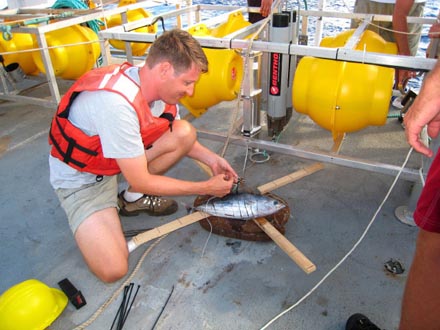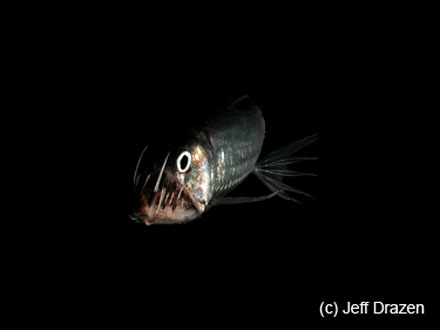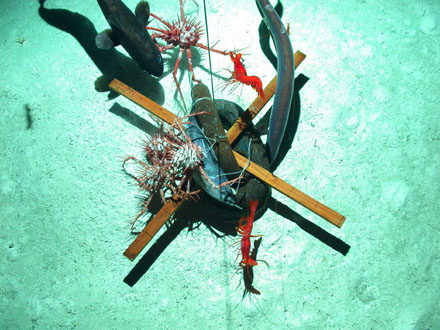|
You
are here: /main/research
expeditions/July 2007/Jeff Drazen Interview
Interview
with Jeff Drazen of the Oceanography
Department, University of Hawaii, Manoa
by Keeley Belva

Jeff Drazen preparing the bait station for
the drop camera
Click
here to see where the Hi'ialakai is now.
Click
here to see current data from the ship.
1. What is your affiliation and where are you from?
I am an assistant professor with the Oceanography Department
at the University of Hawaii, Manoa. My specialty
is the study of deep-sea fish ecology and physiology. I
moved to UH 3 years ago from the Monterey Bay Aquarium
Research Institute where I was doing my post-doctorate
work in the deep canyon off the coast of California. Before
that I did my doctorate work at the Scripps Institution
of Oceanography in San Diego. Hawaii has been
a fantastic place to do research because we are surrounded
by the ocean and you can reach very deep water only a few
miles offshore.
2. How did you become interested in your particular field/profession?
I have always been interested in the ocean and the animals
that live there. My grandparents lived on the Puget
Sound in Washington State where I grew up. My summers
were spent exploring the tide pools, setting up aquariums
and fishing. I could spend hours watching an anemone
unfurl its tentacles or a fish set up and defend its territory
in one of my aquariums. My first introduction
to the deep sea was in college. I was lucky enough
to have professors who showed us deep-sea animals in class
and took us to sea to collect them in trawls. Wow,
the amazing shapes, strange adaptations, the fangs of the
viperfish, the vivid red of a deep-sea shrimp! And
they all lived in a habitat that was perpetually cold, dark,
under crushing pressure, and with little food. I dug
more into what we knew about the deep sea and its inhabitants. It
became apparent that there was a lot that wasn’t understood
about how these animals make a living down there and there
were huge areas that weren’t explored.
 Viperfish, Chauliodus
macouni. Credit: Jeff Drazen Viperfish, Chauliodus
macouni. Credit: Jeff Drazen
3. Have you worked in the Hawaiian Archipelago before?
Or the Northwestern Hawaiian Islands?
Most of my work has been done off of California because I
have only recently moved to Hawaii. However, my graduate
students and I have been investigating deep-sea communities
in the main Hawaiian Islands since I arrived, including both
oceanic and bottom living deep-sea animals. This research
cruise is my first venture to the NWHI.
4. Have you worked on a ship at sea before, such as this one?
I started going to sea on oceanographic vessels 15 years
ago as an undergraduate student. Since then I have
been to sea many times in California, Hawaii, Oregon, Washington,
Mexico and two research cruises to Antarctica. I spend
about 30-40 days a year at sea. A highlight of my career
was diving in the Alvin and the Pisces
submersibles. Several
dives were 2.5 miles deep off of California.
5. What are your areas of interest, or your expertise?
My focus is the ecology and physiology of deep-sea fishes. I’ve
always been fascinated with fishes and deep-sea species are
incredibly diverse and important members of the deep-sea
ecosystem. I want to understand how they are adapted
to the conditions of the deep ocean and what role they play
in deep-sea food webs. My work began using traps and
trawls to catch fishes and study what they eat, how much
they eat, and whether this changes between summer and winter
as it does for many shallow water fishes. Since that
time I have studied fish communities using remotely operated
vehicles (ROVs), submersibles, and autonomous cameras. I
have also developed ways to capture and maintain deep-sea
fishes alive in captivity, including a high pressure trap
that can catch an animal at up to 2.5 miles deep and return
it to the surface alive.
6. What excites you about working with these organisms?
Working in the deep sea is a bit like being an explorer on
another planet. Around every corner lies another
alien life form, sometimes undescribed, with a unique way
of participating in the community and living under extreme
conditions. I love discovering new things and the
deep-sea is full of them.
7. Any favorite stories about a particularly unique organism from your
field of interest, such as a unique story of working with them, their ecology
or unique adaptation the organism may have?
I was studying the feeding of a rattail fish from about 3500
feet off of California. Studying diet means a lot of
tedious work identifying half digested animals that the fish
ate. It’s hard but fun if you like puzzles and
if you can get past the smell. I remember one day I
had a piece of rattail food that I couldn’t identify. It
was long and fibrous and at the top it had lots of little
round structures, almost like tentacles and mouthparts of
a sea cucumber, but I couldn’t find a head to the thing. After
consulting books and comparing its features to nearly every
phylum in the animal kingdom, I remained stumped. I
started asking some of my colleagues for help. One
friend looked through the microscope and in about 2 seconds
stated, “It’s a piece of broccoli.” Sure
enough, once I stopped considering only animals forms, it
was obviously a piece of broccoli! The fish had been
collected from near a shipping lane off San Diego and must
have eaten the kitchen scraps tossed overboard by a passing
boat. Later I found onion and orange peels in other
fishes’ stomachs from the same area. This was
funny but also interesting. I further determined that
many of these rattails ate surface living fishes and squids
that had died and sunk to the deep-sea floor. This
species scavenged to make a living, in a place where food
was in short supply. But most importantly, what
the broccoli showed me, was that despite the apparent remoteness
of the deep sea, thousands of feet below and out of sight,
it is affected by what we do at the surface.
8. Why were you interested in coming on this expedition?
The deep sea is the largest environment in the Monument but
it is the least explored. Throughout the world the
deep-sea is the single largest living space. 70% of
the earth’s surface is oceans and 90% of that covers
oceans deeper than 500m. The Monument is similar. The
island chain is more than the sandy atolls and rocky islands
that we see above water. It is also a complicated terrain
of under water mountains, ridges, and abyssal plains. The
Hawaii Undersea
Research Lab has worked in the NWHI and has
conducted submersible dives to about a mile deep. We
are exploring the Monument’s deep-sea communities to
2.5 miles depth for the first time. This cruise
was an incredible opportunity to study this region and provide
some of the first descriptions of what lives there.

Bighead grenadier, Coryphaenoides rudis,
cutthroat eel, Synaphobranchus oregoni,
king crabs, Lithodes nintokuae,
deep-sea shrimp, Aristeaopsis sp. Taken off Lisianski
Island at 4,650 feet below the surface. Credit: Jeff Drazen
9. What do you hope to find during this research
trip?
Because the Monument’s deep-sea habitats are relatively
unexplored the first step is simply to describe what is there. Our
primary data collection tool is a baited camera system. This
instrument is dropped from the ship to sink to the seafloor. The
camera takes images every 2 minutes for about a day. Most
animals in the food poor deep-sea are attracted to the bait. So
despite relatively low numbers we can photograph, identify,
measure and count many of the animals that live in the area
where the camera was dropped. By using some statistics
that incorporate when a particular type of animal arrives
and how many are attracted we can estimate the density of
the species in the area. To retrieve the instrument
we send a coded sound pulse down to it, which tells the system
to drop its anchor and float back to the surface where the
ship can pick it up. Although this approach is
not as comprehensive as a submersible, it is relatively inexpensive
and can be done as part of a cruise with many other research
objectives. We can drop the cameras in the morning
and then other scientists can conduct dive operations during
the day.
We hope to describe the diversity and community composition
of the animals living in the Monument’s deep-sea areas. This
is the first step in understanding how these communities
function and how their members are adapted to their environment. Camera
studies, such as ours, have focused on temperate relatively
productive areas of the oceans. The NWHI are in the
middle of the subtropical pacific where productivity is very
low. This means comparatively less food for the
deep which could affect the types and numbers of organisms
that live there. Depth strongly affects diversity and
community composition, so we will deploy our cameras from
about 1500 ft to 2.5 miles deep. We should see changes
in the community with depth. It is also likely that
we will find some species previously thought to be rare or
those from the deep Pacific but not yet recorded from the
NWHI. The deep sea is rather consistent over large
expanses so we certainly expect to see many of the animals
that live in the main islands in the Northwestern Islands. What
will be more interesting is to determine if some species
from the equatorial or far eastern Pacific are also present
in the Monument. Certainly there could be new species
to be discovered.
10. What do you think is the benefit of this work
to conservation in the Monument?
In many parts of the world the deep sea is under threat. Fishers
that have overexploited shallow water stocks move into deeper
water, often times before managers even know what the resources
are, let alone how to manage them. Orange roughy, grenadier,
and Chilean seabass are all deep-sea fishes. The deep
sea has also been used for a sewage dump, a trash dump, for
radioactive waste disposal, and as many people in Hawaii
know, as a dumping site for explosives, chemical agents and
military ordinance. To understand the impacts of our
activities on these ecosystems we need to have a baseline
of information from relatively undisturbed areas. The
NWHI are relatively free from these impacts but the main
islands are certainly not. By studying both we may
be able to assess the magnitude of our impacts where they
do occur. The NWHI should provide a baseline for how
the system should function in a natural state.
The Monument
is not protected from global climate change. As
we add carbon dioxide into the atmosphere some of it enters
the oceans. This has the effect of making the oceans
more acidic, or lowering its pH. The oceans are already
more acidic than they were 100 years ago and the trend is
accelerating. Some of the studies that scientists have
done on the metabolism and physiology of deep-sea species
suggests that they can not cope with rapid changes in pH. These
animals have evolved in an environment that has been relatively
stable for 1000’s of years and does not experience
daily or even yearly changes in pH. The increasing
acidity will reduce their ability to extract oxygen from
the water and could impact their activities and growth. By
describing these communities now we can gauge any future
impacts.
Click
here for maps of the region
|